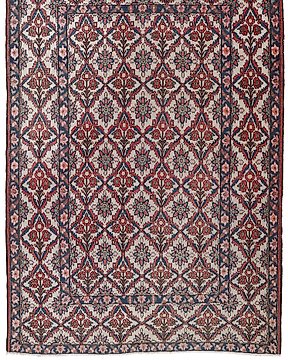
Isfahan Antik - Teppich - 195 cm - 150 cm
Nr. 83134969

Nr. 83134969

Knot density: approx. 160.000 knots/sqm
Pattern: Bakhtiar Medallion
Province: Bakhtiar Iran
Condition: Very good condition
Material: pile 100% new wool - warp 100% cotton - 100% natural colors
Age: approx. 1950 (Persian carpets are legally considered antique if they are over 70 years old). Other objects over 100 years old
Bakhtiar (Bakhtiar) Persian carpets
Bakhtiar rugs are made from strong, durable wool. Named after the Bakhtiari nomads who live in the Sagros Mountains near the city Isfahan lived, this carpet is the most robust of all Persian carpets. They are bound with thick wool to reduce wear and tear. Although it is not as fine and soft as the cork wool of other Persian carpets, it has the decisive advantage that it can withstand everyday wear and tear.
Bakhtia rugs are often made with motifs reminiscent of gardens. The so-called Chesty pattern is characterized by designs with motifs of plants and animals from nature. Inspired by a typical Persian garden. Occasionally, Bakhtiari carpets can be found with patterns resembling those of the nearby Isfahan carpet production area.
Structure
Bakhtiari rugs are based on a cotton base (warp) with a wool weft usually sourced from the producing tribe's herds. This results in unique rugs that differ according to the characteristics of each tribe's wool. The wool can range from matte to extremely shiny, and the resulting pile is cut from medium to high. The best carpets with the highest knot density are often referred to as Bibiaffs.[6] [a] Prices vary significantly and rugs with the highest knot density are generally the most expensive, but price is also influenced by criteria such as the motif and pattern dyes used. Plays by Chapel Shotur and Saman are rated slightly below Bibibaff productions, but are still rated good to excellent. Widely woven and of inferior quality, hori rugs are generally largely affordable as a result.
Sizes range from narrow entrance rugs to large room designs measuring up to 4m × 5m thick. Larger rugs tend to be very rare and difficult to find. Likewise, older rugs, which are often coveted by collectors, can be extremely expensive.
Models
The motifs are usually inspired by flowers or the garden. Khesti, an established garden motif, is perhaps the best-known carpet design. The carpet is divided into individual squares in which animals and plants act as symbols. Another influential design features a field decorated with lattice motifs and floral ornaments.
Colors
The use of colors varies according to the style of some tribes. They generally include shades of white, red, brown, green, and yellow. Blue doesn't seem to be there. [Citation needed] Natural dyes produce color variations that are particularly noticeable in older Bibibaffs.
What is a real Persian rug?
An effective test to determine the authenticity of a Persian rug is to press the fleece with your finger. As you move the tufts of wool, you can see the individual threads and knots of a real rug. This means that in this case the carpet is genuine.
What types of Persian carpets are there?
Types of Persian carpets are generally classified into three categories: urban, village and tribal. They are all named after the town or village where they were made, or the tribe that made them. City rugs are of the highest quality.
How long is the lifespan of a Persian rug?
Keywan Ilanlou: In Europe, Persian rugs are mostly family heirlooms and on average 50-60 years old.
How are Persian carpets made?
Precious Persian carpets are made from natural materials. This may vary by region of manufacture. Cotton, wool and silk are mainly used. For example, nomads mainly use wool from sheep they raise themselves.
“Errors and mistakes excepted”
So kaufen Sie auf Catawiki
1. Etwas Besonderes entdecken
2. Höchstgebot abgeben
3. Sichere Zahlung durchführen